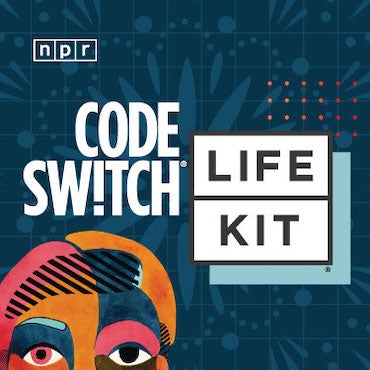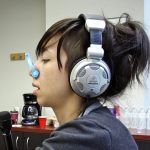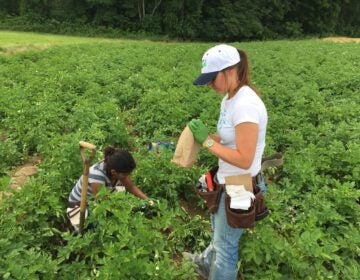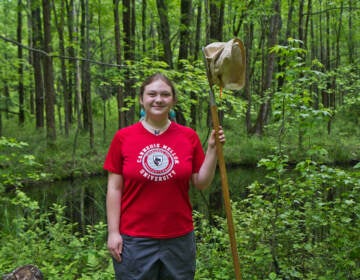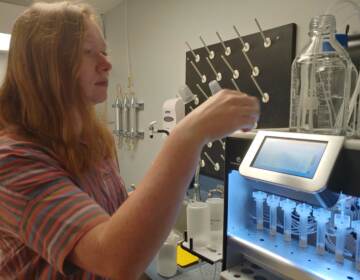Why scientists say ‘plastivores’ could be the solution to plastic pollution
Worldwide, researchers are hunting for a kind of `secret sauce’ — a souped-up enzyme capable of breaking down some of the most resilient plastics.
Listen 12:03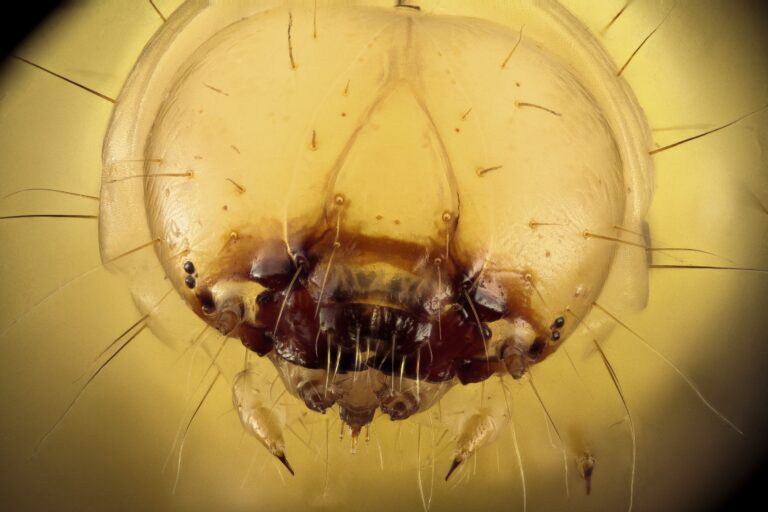
Worldwide, researchers are hunting for a kind of `secret sauce’ — a souped-up enzyme capable of breaking down some of the most resilient plastics. (Photo by Sam Droege/Wikimedia Commons)
This story is from The Pulse, a weekly health and science podcast.
Subscribe on Apple Podcasts, Stitcher or wherever you get your podcasts.
In 2016, Erika Erickson was a brand-new biochemist, fresh off her Ph.D. in plant biology, when she decided to spend a year volunteering with the Peace Corps. She was assigned to a small village in the West African country of Guinea.
Picture mud huts with thatched roofs, surrounded by unspoiled, stunning nature.
“It was absolutely gorgeous,” Erickson remembered. “There’s very little development. And so for anyone who’s an outdoor enthusiast, it was kind of a magical place.”
But Erickson’s job wasn’t to marvel at all the beauty around her. She was there to think about resilient systems. And one of her big projects was figuring out how to keep waste from ending up in the environment — specifically, nearby fields and the streams that local residents used for their drinking water.
Guinea is one of the poorest countries in the world, which means that in a lot of places there’s little to no waste management. Instead, many people dump their trash by the roadside — and a major portion of it is plastic.
“So in cities along the coast, it’s really not uncommon to find that the ditches are full of trash,” Erickson said. “And then after a big rainstorm, that’s all floated down and is covering the beach.”
Farther inland, piles of plastic waste meet a different fate — burning.
“The smell is horrendous,” Erickson said of the unmitigated fires that burn in roadside ditches.
But Erickson’s time in Guinea also convinced her of another truth about plastic — that it had the ability to change people’s lives for the better.
“We’re talking about a place where there are no sinks, there’s no running water,” Erickson said.
As a result, people — often women — are tasked with the grueling job of fetching water on foot for drinking, cooking, and cleaning.
“Without a large assortment of plastic jugs to carry that in, it’s just a really complicated ordeal,” Erickson said.
Traditionally, receptacles have been made by hand — a chore that’s both time-consuming and resource-intensive.
“Doing the laundry, same thing,” Erickson said. “If you have to build your own waterproofed tubs from natural resources and things available in your environment, it’s just really challenging.”
Plastic also made it much easier to access and transport potable water, which is sold in small plastic sachets.
“This is an indispensable resource for keeping people healthy.” That’s especially true, Erickson says, for people who are sick, children, and the elderly.
“So you could get clean water; things that had been exorbitantly expensive supplies to get before were available at a price that people could afford,” Erickson said. “And so it was a really necessary thing, I think, for development and for bringing people’s standards of living up to a place where there’s less illness and a lot more comfort.”
The problem was, there was no good way to deal with the aftermath of all that plastic.
This, Erickson said, framed for her the central dilemma: As much as we might want to reduce our use, we are heavily dependent on plastic. And what’s at stake isn’t just straws and extra grocery bags — in some cases, it’s the lives and health of people around the world.
It’s a big part of what pushed Erickson into the work she does now at the National Renewable Energy Laboratory, or NREL, a government-funded lab based in Colorado — finding ways to decrease the environmental harm of plastic rather than getting rid of it altogether.
The problem with how we recycle plastic now
Plastic is made primarily from something we already use to make nearly every synthetic material you can think of — fossil fuels.
“Plastic is highly abundant, pretty dispersed across the planet, and has a lot of really good energetic bonds in it that we can use for new products and energy that way,” Erickson said.
Her lab works with a bigger group called BOTTLE (the Bio-Optimized Technologies to keep Thermoplastics out of Landfills and the Environment consortium), which is trying to figure out a way of unlocking that stored energy while at the same time tackling the growing problem of plastic pollution.
One of the worst offenders when it comes to plastic pollution is PET, or polyethylene terephthalate. It’s easier to recycle than a lot of other plastics, but there’s also a lot of it out there.
“This is used in a lot of single-use plastics, like your soda bottles, your water bottles, your takeout food containers,” said Brandon Knott, one of Erickson’s colleagues at NREL. “You know, they’re sort of designed for single use. They’re really lightweight, so they’re easier to escape out of where they should be. And they end up in the places where we don’t want them — namely out in the environment.”
Unless, of course, they get recycled in one of two ways.
The first is what’s called “mechanical recycling,” which basically means the plastic gets crushed up, melted down, and then reused. But there are a couple problems with mechanical recycling.
For one thing, contamination by dirt and other plastics makes it difficult to fully break down the plastic. Another is that the process of mechanical recycling causes the plastic to degrade, meaning that the resulting product is of worse quality. It typically gets remade into lower-price goods, like carpet or park benches, and eventually ends up in a landfill.
The second big option, after mechanical recycling, is simply burning the plastic, Erickson said.
“A lot of places will take all of the waste, mostly plastic, and just burn it and use this as heat,” she said.
Subscribe to The Pulse
The promise of ‘plastivores’
But what if there were a way to break plastic down to its constituent parts — parts that would either not be harmful to the environment, or could be reused to make new plastics?
As it turns out, there is something that has that ability, but it’s not some kind of solvent, or chemical process — it’s a life form called “plastivores.”
“Individual organisms that use plastic as their primary carbon and energy source,” Erickson said. “So they can live off of nothing but plastic, which is pretty wild to think about.”
In 2016, Japanese scientists discovered the first plastivores in the form of a bacterium that was able to survive solely on PET bottles.
“The reason I say that’s kind of wild to think about is that plastic, PET, was invented in the 1940s — I think, early 1940s,” Erickson said. “So that’s not very long for an organism to decide that that’s a good, tasty meal.”
The discovery kicked off an international race among scientists to identify the key to this bacterium’s success: the enzymes, or proteins, that are responsible for breaking the plastic down.
Since then, the research on plastivores has expanded in all directions, including the recent discovery of our first animal plastivore: the humble wax worm.
Looking for wax worms’ secret weapon
Canadian biologist Christophe Lemoine said a European team made the discovery in 2017, entirely by accident.
“Kind of the funny story behind that is that one of the team members is actually a beekeeper,” Lemoine said. “And what happened is that she was just cleaning her hive and found some of those wax worms, put them in a plastic bag, wrapped them up, put them on the kitchen counter, and a couple of hours later, the wax worms were happily sneaking their way out of the plastic bag. So that’s kinda what put the wax worm on the international scene.”
The big mission after that discovery was figuring out what the mystery enzyme or enzymes were that allowed wax worms to break plastic down.
Lemoine, who’d been studying the effects of microplastics on animal physiology, teamed up with an insect biologist to find out how exactly wax worms were able to digest plastic. It was, in other words, a different version of the same mission other scientists have been on — zeroing in on the magic formula for breaking plastic down.
“Our goal was to try to decipher whether it was the bacteria or the wax worm that was doing that stuff,” Lemoine said. “So essentially trying to figure out if the bacteria was really mostly responsible for the other plastic breakdown, the polyethylene breakdown, or if it was the worm.”
In March of last year, Lemoine and his colleagues released a study with the beginnings of an answer. It showed that the wax worm’s digestive microbes were the bigger factor in their ability to break down plastic — but it also showed that the microbes on their own didn’t work as efficiently as they did in the guts of the wax worm.
“We’re still pursuing that question,” Lemoine said, “trying to figure out what is this synergy between the bacteria and the wax worm that allow them to really accelerate this breakdown of plastic.”
An ambitious bid to scale up enzyme recycling
The ultimate goal with all of this research is to isolate the enzyme — the secret sauce, if you will — that’s responsible for achieving that breakdown, improving it, and hopefully applying it on an industrial scale.
Most of the scientists I talked to said we’re still years away from making that a reality — except for one: French biochemical engineer Alain Marty.
“We are now building a demo plant and it will be in operation in September 2021,” Marty said. “And after this, the idea is to have a first industrial plant in 2024.”
Marty is the chief science officer for a French company called Carbios, which last year announced that it had synthesized an enzyme capable of breaking down PET 10,000 times faster than the bacterium discovered by Japanese scientists.
Marty described the enzyme and its substrate as a lock and a key. His job, along with his group, was to improve the lock (the enzyme) so that it better fit the key (the PET). And, Marty said, they’ve been successful. When the group started in 2015, it took several weeks to degrade just 2% to 3% of PET. But today, the best result has been to degrade 90% in 10 hours.
Not only that, Marty said, they’re able to break the plastic down to its constituent elements, pure enough to reform plastic of equal quality to the original.
Carbios has already scored investment from major companies like L’Oreal and PepsiCo, Marty said, and the goal is to open recycling plants around the world, capable of handling 100,000-200,000 tons of plastic every year.
Part of a bigger solution
But some scientists caution that although these developments are exciting, they aren’t a solution — at least not yet.
“This cannot be the main idea,” said environmental microbiologist Hermann Heipieper. “These processes are very, very expensive so far and need to be supplemented.”
Heipieper should know: Last year, he led a group of German researchers in discovering a strain of bacteria capable of degrading key building blocks of polyurethane, another widely used plastic that’s particularly difficult to recycle.
But when asked about the promise of enzymes like the ones Marty or his team have uncovered, Heipieper instead points to other solutions.
“One thing is clear — we cannot go on as we do,” Heipieper said, referring to the pervasiveness of single-use plastic. “The main thing must be that we stop using crude oil-based plastics.”
Secondly, Heipieper said, scientists should lobby legislators to encourage that we switch over to different, more degradable plastics.
Heipieper isn’t alone in this approach.
In September 2020, the NREL group Erika Erickson and Brandon Knott are a part of put out a study describing the second of two key enzymes capable of breaking PET down. But they, too, are cautious about the discovery’s potential.
“We should be really excited about the advances that are being made in terms of enzymes breaking down PET,” Knott said. “But there are lots of different types of plastics, and we need solutions to recycle and upcycle all of them. Enzymatic degradation of PET is one piece.”
There’s no one solution, Knott said. We need ways of degrading and reusing all different kinds of plastic — and of inventing new plastics with end-of-life in mind. And maybe most importantly, we need to decrease our plastic use in general.
At the same time, we have to remember that plastic waste isn’t just wrappers and straws — in places like the Guinean village where Erickson lived, it’s health, clean water, and resources and workforce hours that would all need to be replaced.
“The social aspects of this are also really important,” Erickson said. “We can come up with new technologies, but we can’t necessarily create a technology to save ourselves. We kind of have to do that from the ground up.”
WHYY is your source for fact-based, in-depth journalism and information. As a nonprofit organization, we rely on financial support from readers like you. Please give today.
